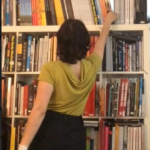









featured gallery for May 2019
Furnishing Evidence
An archive is, as I heard another archivist claim recently, fundamentally evidential. This evidence is both of itself (it reveals its process), and of the material it’s archiving (it speaks to what created it). For the past year, I have been working in the archive and estate of the late photographer Tseng Kwong Chi. The images I am highlighting for this gallery are all previously unpublished photographs of Tseng’s, digitized and introduced to the Visual AIDS Artist+ Registry in concert with this month’s web gallery.
Between his well known 10 year long expeditionary self portrait series, the tens of thousands of photographs he took of close friend and collaborator Keith Haring, his formal portraiture and more candid shots of the semi-hidden, troubled-paradise 80s downtown art club scene, Tseng has an exceptionally ranged public oeuvre. Since his passing, his archive and estate, under the direction of his sister Muna Tseng, has always been ardently invested in preserving and promoting Tseng Kwong Chi’s cultural legacy. Beyond how close the siblings were—including having shared the New York apartments that sometimes doubled as Kwong Chi’s studios—Muna has demonstrated her value as artistic executrix via the same combination of romanticism and rationale that make her a great choreographer. It is in recognition of her round-the-clock efforts that Visual AIDS has chosen to honor her at their Visual AIDS Vanguard Awards VOOM benefit this May. The weight of care that the estate needs to thrive is hard to quantify. The archive is lucky to be so loved! But by default, deep within the archive are photos of Tseng’s that are unremembered, or consigned to a lesser visibility. It is a treat to have this time to work with a few of these.
“The idea of the archive,” Nayland Blake said in Visual AIDS’ DUETS publication on Jerome Caja, “changed with the AIDS crisis.”1 I’ve been thinking about this in relation to the widely quoted part of On Photography where Susan Sontag writes that “to take a photograph is to participate in another person’s (or thing’s) mortality, vulnerability, mutability”, and that “...all photographs testify to time’s relentless melt.”2 On one hand, here the nod to mortality is evident. Cookie Mueller, Keith Haring, Martin Burgoyne, and a photo from Burgoyne’s 1986 Pyramid Club benefit event for medical costs evoke explicit moments to consider the clever, daring people who have been lost to AIDS-related causes.
On the other hand, and diverging from the stiff-shouldered, ambassador character he becomes for much of his self-portrait series, those portrayed in these select Tseng photos combat the idea of being frozen. They are actionable and lively. Everybody here resists stillness, even though photography principally demands it of them. Full of a lovely ebullient kitsch, they ask us to agree, for a moment, to bypass the issue of time.
To conclude, I thought I could share a rich behind-the-scenes anecdote: the ‘Bad Boy’ shirt that Keith Haring wears in a well-known portrait by Tseng Kwong Chi is from the same run (even perhaps the same night), as the shirt seen crumpled up in the bottom left corner of the photograph Bad Boy night, Danceteria, New York, 1986, having been taken off by the dancer lying on the floor, we imagine, just a few moments earlier. When brought into daylight, the shirt leads a life beyond its ephemeral nightlife origins. It both disappears the context it was created for and unabashedly wears it. In other words, it totally screws with time’s relentless melt.
1DUETS, Jerome Caja: Nayland Blake & Justin Vivian Bond. Visual AIDS, 2018.
2Sontag, Susan. On Photography. Farrar, Straus and Giroux, 1977.
